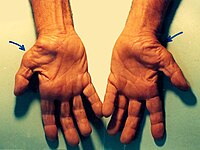
Photo from wikipedia
To the Editor: We read with great interest the guest editorial by Dr Fowler1 arguing against the routine use of electrodiagnostic studies in patients with carpal tunnel syndrome. This guest… Click to show full abstract
To the Editor: We read with great interest the guest editorial by Dr Fowler1 arguing against the routine use of electrodiagnostic studies in patients with carpal tunnel syndrome. This guest editorial generated letters to the editor from Bland2 and Magnussen and Morren.3 We believe that further important concerns related to this topic need to be addressed. First, the cornerstone of Dr Fowler’s1 guest editorial is that electrodiagnostic studies should not be routinely used in patients who present with a clear-cut history and physical examinations because, as he states in his response to the letter to the editor by Magnussen and Morren,3 “no useful additional information would be gained by performing electrodiagnostic testing.” This argument is mainly based on the assumption that electrodiagnostic studies are merely a “confirmatory test” or “gold standard of diagnosis” that are ordered unnecessarily in patients with a straightforward diagnosis. However, despite this point of view, the role of electrodiagnostic studies in carpal tunnel syndrome is not exclusively limited to confirmation of diagnosis. Even in patients with a clear clinical diagnosis, electrodiagnostic studies can provide a reliable baseline for future follow-up, particularly when surgical release has failed to resolve the symptoms. Despite Dr Fowler’s1 claim that “postsurgical changes in nerve conduction velocity after carpal tunnel release is poorly studied,” several well-designed studies have shown the value of nerve conduction studies in the postsurgical follow-up of the patients.4,5 Given these considerations, a serious question must be asked: How can a hand surgeon distinguish a previous median nerve degeneration or an ongoing median nerve compression in patients with recurrent or persistent symptoms following surgical release when no baseline electrodiagnostic study results are available? Perhaps it is apparent that besides its clinical implications, this question also carries significant legal connotations. These notions are in addition to other practical roles of electrodiagnostic studies in carpal tunnel syndrome, such as providing a “grading scheme” basis for treatment decision-making and outcome assessment, described in one of the previous letters to the editor.2 Second, the idea that electrodiagnostic studies are unnecessary in patients with “classic” presentation and that electrodiagnostic studies should be limited to patients with atypical symptoms should be viewed with caution. We believe that Dr Fowler has not considered several neuromuscular disorders that can clearly mimic the clinical presentation of carpal tunnel syndrome. These conditions may be misdiagnosed as carpal tunnel syndrome and may not be disclosed unless electrodiagnostic studies are performed. An example is the reported case of a girl with Hirayama disease who was clinically misdiagnosed as having advanced stage carpal tunnel syndrome and was to have surgical carpal tunnel release when electrodiagnostic studies were not performed.6 Other median nerve pathologies, such as median nerve compression in the forearm, can masquerade as carpal tunnel syndrome because the 2 entities can hardly be distinguished clinically. Given these limitations, it seems that basing an invasive treatment (ie, surgical carpal tunnel release) on merely positive history and physical examination is of questionable merit. Arash Babaei-Ghazani, MD Peyman Roomizadeh, MD Tehran, Iran The authors have no relevant financial relationships to disclose.
Journal Title: Orthopedics
Year Published: 2018
Link to full text (if available)
Share on Social Media: Sign Up to like & get
recommendations!